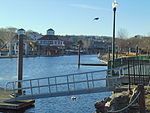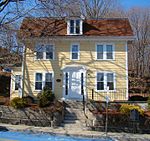American Thermos Bottle Company Laurel Hill Plant
The American Thermos Bottle Company Laurel Hill Plant, located in the Laurel Hill section of Norwich, Connecticut, in the United States, includes 11 contributing buildings and two other contributing structures. The original plant was built during 1912–13 and used a historic Italianate house as a company office building. The plant was the primary factory where Thermos brand vacuum flask bottles were manufactured from 1913 to 1984. The plant is historically significant to its connection to the Thermos Company and the history of Norwich. The complex is architecturally significant because it displays the adaptive use of industrial mill design to new industry. It was added to the National Register of Historic Places in 1989. Since its nomination, numerous changes and renovations have occurred. The surrounding area has seen the construction of condominiums and the large manufacturing building being renovated and re-purposed for loft-style apartments. Renovations on the northern end of the property would require the demolition of two buildings to construct the Integrated Day Charter School. Completed in 2008, a new two-story addition created an indoor gymnasium, kitchen, offices and a new lobby for the school.
Excerpt from the Wikipedia article American Thermos Bottle Company Laurel Hill Plant (License: CC BY-SA 3.0, Authors).American Thermos Bottle Company Laurel Hill Plant
Thermos Avenue, Norwich Thamesville
Geographical coordinates (GPS) Address External links Nearby Places Show on map
Geographical coordinates (GPS)
| Latitude | Longitude |
|---|---|
| N 41.510277777778 ° | E -72.078611111111 ° |
Address
American Thermos Bottle Company Laurel Hill Plant
Thermos Avenue
06360 Norwich, Thamesville
Connecticut, United States
Open on Google Maps











